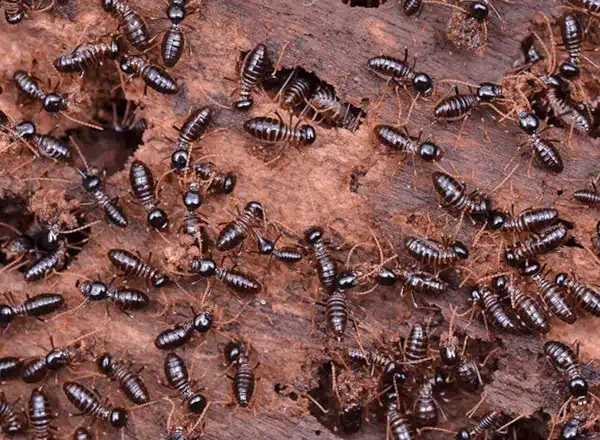So if a tree falls in the woods and no one is close enough to hear the sound, did it make a sound? And if termites eat the tree up, and no one was there to hear the sound, would these termites make the sound of munching? These are some deeply philosophical questions that honestly I don’t have the answer to. But what I can tell you is all about termites. In this article let’s explore termites, their lifecycle and what we can do to stop them from feeding on our homes businesses.
TERMITE DEVELOPMENT
People often confused termites ants, but one area where they are very different and is in their metamorphosis. Ants go through a complete metamorphosis, where termites go through an incomplete metamorphosis. Because of this, termites begin as an egg laid by the queen. Once they hatched, a nymph emerges. This nymph is in the same form as the adults, but much smaller. A nymph will grow as it feeds and time passes and eventually outgrow the exoskeleton that it was hatched in. It will have to molt from that exoskeleton, much like a snake molts its skin. It will do this a number of times before it reaches adulthood.
Termites are eusocial insects. This means that they live in a colony. They have a caste system that they use to complete the tasks necessary to keep the colony moving and doing what it needs to do. At the bottom of the caste system are the worker termites. Workers are tasked with the most menial jobs in the colony. They forage for food, eliminate waste, tend to the young, bring food back to the colony and many other tasks. The majority of the individuals in the colony are workers. Call your Tulsa pest control company today.
SOLDIERS AND REPRODUCTIVE TERMITES
Next we have a soldier termites. These termites are equipped with large heads and large mandibles in order to protect the colony. If an invading army of ants advance attacks the colony. Then these insects come alive and go to work. They will enter the foray and attack the ants head-on. Their large heads will clog up the tunnels as the workers close the tunnel behind them. These termites will give their lives for the colony. The ants will carry off the soldier, but the rest of the colony will remain safe.
Lastly we have the reproductives. The queen is the head of the entire colony. She lays all the eggs for her colony. Many of these colony’s individuals number into the millions, so she lays eggs night and day. Another part of the reproductive‘s are the swarmers. These are flying termites that are released in April and May of every year. These flying termites will swarm looking for a mate from another colony. If they find a mate, they will mate, find a suitable place for building a new colony, lose their wings, and start the new colony. The royal chamber is dug out by the king. Here the queen will lay her first eggs. The king will tend to the eggs until those eggs hatch and grow to full adulthood. Those adults will be the first generation of workers and the king will die off.
ANTS AND TERMITES
As I said earlier, it’s sometimes difficult to tell the difference between ants and termites. But there are some telltale signs. If you see what you think is a termite, take a look closer look at the insect itself. Ants have three distinct sections of their body. They have a head, an abdomen, and a thorax. Between each of these body sections is a very small waist. Termites do not have these waists. Their body is the same width from head to tail. If you’re seeing winged termites or ants, it’s important to take a good look at the wings. If the wings are longer than the body of the insect, then you have termites. It’s time to call in the best Tulsa pest control company. If the wings are the same length as the insect then they are most likely flying ants.
SIGNS OF INFESTATION
There are a few ways to tell if you have termites attacking your home. If it is in the months of April and May, and you’re seeing flying termites caught in your windowsills, then you have a problem with termites. Another telltale signs of termite infestation are mud tubes. These insects need high humidity air to be able to survive. Underground, the air is humid enough to keep them from drying out and dying. When they are above ground, they will build mud tubes in order to bring the high humidity air up above ground and still be able to forage for food. They will build these mud tubes up your cinderblock foundations or plastic siding in an effort to find the wood or drywall that they can feed upon. If you’re seeing these mud tubes, it’s time to contact your Broken Arrow pest control company.
Lastly there are two kinds of ways dealing with termites. Liquid treatments create a liquid pesticide barrier around your entire house. Termites forage through the top 6 inches of the soil looking for deadwood to feed upon. So a 6 inch trench is dug all the way around your house and it’s filled with pesticide and pesticide treated dirt. Any place where cement comes up to the house, technicians will drill holes and force pesticide underneath the slab. This will create a barrier that protect your home. The second method is using a termite bait station system. These stations are positioned around your house in a barrier form. When the termites find the bait station, they remove the bait and take it back to the colony wiping out the colony. Both methods are very good if done by a reputable Broken Arrow exterminator.
DEALING WITH TERMITES
If you find yourself in a position where you’re having trouble with termites or think that you might have termites it’s time to call in a professional Tulsa exterminator. TermMax Pest Control is the best exterminator in town. We service the greater Tulsa area including Broken Arrow, Sand Springs, Coweta, Catoosa, Jenks, Bixby, Claremore, Owasso, Turley, Prattville and much more. Call us today for a free estimate. We’re here to help!



